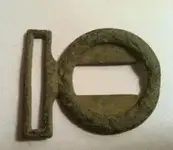mangum
Bronze Member
- Joined
- Jul 2, 2012
- Messages
- 2,319
- Reaction score
- 3,532
- Golden Thread
- 0
- Location
- Charlotte, North Carolina
- 🏆 Honorable Mentions:
- 1
- Detector(s) used
- AT Pro, MXT Pro Back-up
- Primary Interest:
- All Treasure Hunting
Iron relics brought back to life! Thanks to Buckleboy's method
Hello all & happy Friday! I've been meaning to post this for a while but have just been busy. I had some iron relics that really needed to be preserved & after researching, trial & error this is by far the best method. Please check out Buckleboy's post on this.
1) Soak the relic in apple cider vinegar, (I used Tupperware) Take out & brush with a steel wire brush as needed to get the rust off. I used a cheap grill brush from Dollar General. Different sized relics will take different amounts of time. The colonial lock took almost 3 weeks. The smaller buckles may only take 2-3 days. Be patient! When the vinegar turns black its time to put in a fresh batch. Oh, & use gloves! The vinegar gets nasty when it turns black. When all of the rust is gone, rinse & dry.
2) Brush (paint brush) the relic with Evaporust immediately after drying. You can purchase this at Autozone. This will stop & get rid of any flash rusting. You can start with this step & soak in Evaporust to start but it is expensive. This may be a good option for a lock with a brass keyhole cover as it will not mess up the patina of the brass, it will only affect the iron. It's also good for any valuable relics you don't want to take any chances on. This also works well on items such as a lock because it will get into the inside well. Electrolysis doesn't do a great job with that aspect.
3) Brush the item with Crisco, yes Crisco. Then bake for an hour or so in the oven at 250 degrees. Take out, let it cool down some & then wipe off any excess Crisco. Be careful! Iron gets hot! This is basically sealing your iron relic & after a few days it will have the desirable black iron look.
That's basically all there is to it! As you can see, the difference is night & day. The colonial lock turned out fantastic! It is one of my favorite relics now. I'm sure the more I do this the better I will get but these results are pretty impressive. Feel free to send me a message if you have any specific questions, I'll be glad to help. I know this isn't a find from today but its a lot different than the iron rusted blob I originally posted. I also think this is helpful to the tnet community as a whole.
A special thanks to Buckleboy for being so helpful & posting some great cleaning tutorials. Buckleboy, feel free to chime in of you have anything additional to add that I may have missed.
Thanks for looking & HH!
Hello all & happy Friday! I've been meaning to post this for a while but have just been busy. I had some iron relics that really needed to be preserved & after researching, trial & error this is by far the best method. Please check out Buckleboy's post on this.
1) Soak the relic in apple cider vinegar, (I used Tupperware) Take out & brush with a steel wire brush as needed to get the rust off. I used a cheap grill brush from Dollar General. Different sized relics will take different amounts of time. The colonial lock took almost 3 weeks. The smaller buckles may only take 2-3 days. Be patient! When the vinegar turns black its time to put in a fresh batch. Oh, & use gloves! The vinegar gets nasty when it turns black. When all of the rust is gone, rinse & dry.
2) Brush (paint brush) the relic with Evaporust immediately after drying. You can purchase this at Autozone. This will stop & get rid of any flash rusting. You can start with this step & soak in Evaporust to start but it is expensive. This may be a good option for a lock with a brass keyhole cover as it will not mess up the patina of the brass, it will only affect the iron. It's also good for any valuable relics you don't want to take any chances on. This also works well on items such as a lock because it will get into the inside well. Electrolysis doesn't do a great job with that aspect.
3) Brush the item with Crisco, yes Crisco. Then bake for an hour or so in the oven at 250 degrees. Take out, let it cool down some & then wipe off any excess Crisco. Be careful! Iron gets hot! This is basically sealing your iron relic & after a few days it will have the desirable black iron look.
That's basically all there is to it! As you can see, the difference is night & day. The colonial lock turned out fantastic! It is one of my favorite relics now. I'm sure the more I do this the better I will get but these results are pretty impressive. Feel free to send me a message if you have any specific questions, I'll be glad to help. I know this isn't a find from today but its a lot different than the iron rusted blob I originally posted. I also think this is helpful to the tnet community as a whole.
A special thanks to Buckleboy for being so helpful & posting some great cleaning tutorials. Buckleboy, feel free to chime in of you have anything additional to add that I may have missed.
Thanks for looking & HH!
Attachments
Last edited:
Upvote
15



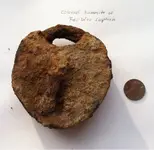
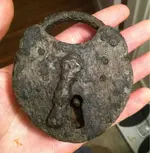


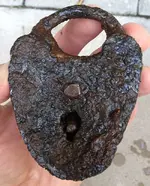
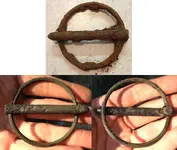

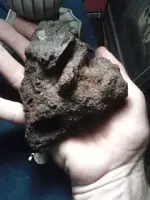
 I'll have to try that ACV method too.
I'll have to try that ACV method too.
